CCNA – Drag and Drop 1
Here you will find answers to drag and drop Questions
Question 1:
A dental firm is redesigning the network that connects its three locations. The administrator gave the networking team 192.168.164.0 to use for addressing the entire netwok. After subnetting the address, the team is ready to assign the addresses. The administrator plans to configure ip subnet-zero and use RIP v2 as the routing protocol. As a member of the networking team, you must address the network and at the same time conserver unused addresses for future growth. With those goals in mind, drag the host addresses on the left to the correct router interface. Once of the routers is partially configured. Move your mouse over a router to view its configuration. Not all of the host addresses on the left are necessary.

Answer:

Explanation:
In short, we should start calculating from the biggest network (with 16 hosts) to the smallest one using the formula 2n – 2 (n is the number of bits we need to borrow).Therefore:
16 hosts < 25 – 2 (we need to borrow 5 bits -> /27)
11 hosts < 24 – 2 (borrow 4 bits -> /28)
5 hosts < 23 – 2 (borrow 3 bits -> /29)
From the available ip addresses, we see that each of them has only one suitable solution (they are 192.168.164.149/27,192.168.164.166/28 and 192.168.164.178/29)
The smallest network is the Floss S0/0 which only requires 2 hosts = 22 – 2 (need to borrow 2 bits ->/30). There are 2 suitable answers: 192.168.164.189/30 and 192.168.164.188/30 but notice that 192.168.164.188/30 is the network address so we can not use it (because 188 = 4 * 47) -> we have to choose 192.168.164.189 as the correct solution.
In fact, it is not the formal way to solve a VLSM question so I recommend you to review your CCNA book if you haven’t grasped it well yet.
Question 2:
In order to complete a basic switch configuration, drag each switch IOS command on the left to its purpose on the right
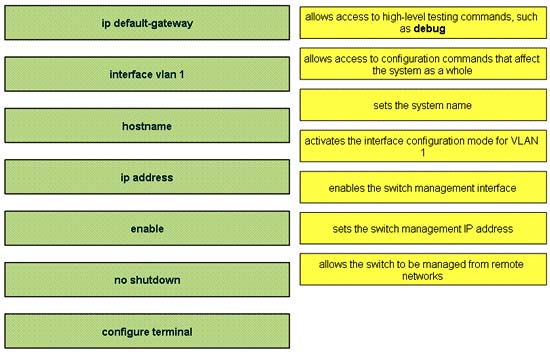
Answer:
1) enable
2) configure terminal
3) hostname
4) Interface vlan 1
5) no shutdown
6) ip address
7) ip default-gateway
Question 3:
The Missouri branch office router is connected through its s0 interface to the Alabama Headquarters router s1 interface. The Alabama router has two LANs. Missouri users obtain Internet access through the Headquarters router. The network interfaces in the topology are addressed as follows: Missouri: e0 – 192.168.35.17/28; s0 – 192.168.35.33/28; Alabama: e0 – 192.168.35.49/28; e1 – 192.168.35.65/28; s1 – 192.168.35.34/28. The accounting server has the address of 192.168.35.66/28. Match the access list conditions on the left with the goals on the right. (Not all options on the left are used.)
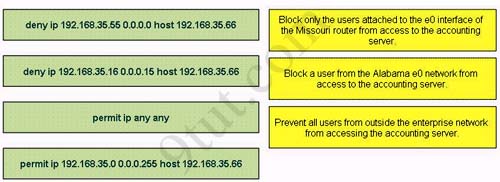
Answer:
1) deny ip 192.168.35.16 0.0.0.15 host 192.168.35.66
2) deny ip 192.168.35.55 0.0.0.0 host 192.168.35.66
3) permit ip 192.168.35.0 0.0.0.255 host 192.168.35.66
Explanation:
1) The wildcard mask of the command “deny ip 192.168.35.16 0.0.0.15 host 192.16.35.66″ is 0.0.0.15, which is equal to network mask of 255.255.255.240 = /28. So the access list will deny all traffic from network 192.168.35.16/28 from accessing host 192.16.35.66, which is the IP address of accounting server.
2) The command “deny ip 192.168.35.55 0.0.0.0 host 192.168.35.66″ will deny host 192.168.35.55, which is a user and belongs to interface e0 of Alabama router (192.168.35.49/28) from accessing accounting server.
3) Because there is an implicit “deny all” command at the end of each access list so the command “permit ip 192.168.35.0 0.0.0.255 host 192.168.35.66″ will only let network 192.168.35.0/24 access accounting server whilst prevent traffic from other networks.
Question 4:
A host with the address of 192.168.125.34/27 needs to be denied access to all hosts outside its own subnet. To accomplish this, complete the command in brackets, [access-list 100 deny protocol address mask any], by dragging the appropriate options on the left to their correct placeholders on the right.
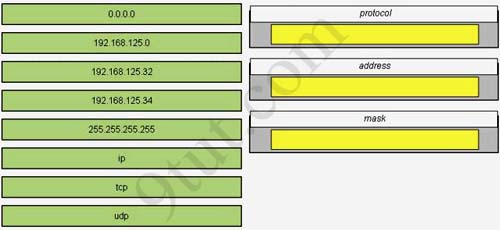
Answer:
1) ip
2) 192.168.125.34
3) 0.0.0.0
Full command: access-list 100 deny ip 192.168.125.34 0.0.0.0
Question 5:
Drag and drop the network user application to the appropriate description of its primary use (not all options are used)
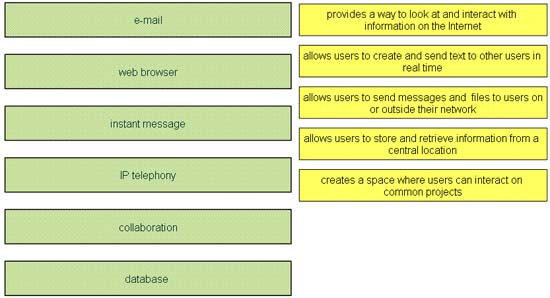
Answer:
1) web browser
2) instant message
3) e-mail
4) database
5) collaboration
Question 6:
This topology contains 3 routers and 1 switch. Complete the topology.
| Drag the appropriate device icons to the labeled Device
Drag the appropriate connections to the locations labeled Connections. Drag the appropriate IP addresses to the locations labeled IP address |
(Hint: use the given host addresses and Main router information)
To remove a device or connection, drag it away from the topology.
Use information gathered from the Main router to complete the configuration of any additional routers. No passwords are required to access the Main router . The config terminal command has been disabled for the HQ router. The router does not require any configuration.
Configure each additional router with the following
| Configure the interfaces with the correct IP address and enable the interfaces.
Set the password to allow console access to consolepw Set the password to allow telnet access to telnetpw Set the password to allow privilege mode access to privpw |
Note: Because routes are not being added to the configurations, you will not be able to ping through the internetwork.
All devices have cable autosensing capabilities disabled.
All hosts are PC’s

Answer:
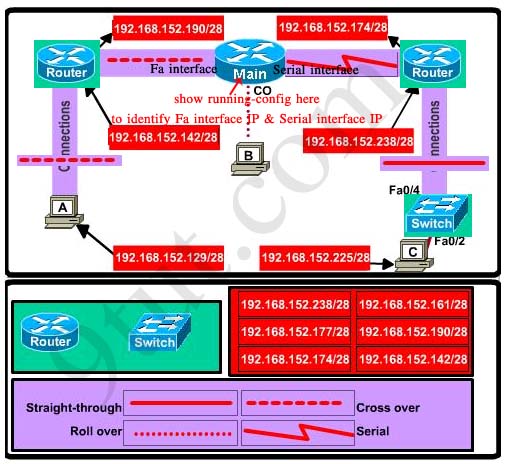
View full explanation of this question here



Hi! Question 6 appear in my exam today. I used this website but didn’t pay good attention to this paticular question and I was almost paying the prcie for it. However, i did manage to get back on track and scored well. I didn’t scroll down the questions and as a result didn’t see the Notes which say I won’t be able to ping between the host and cable sensing not there. As I am not able to test by pinging I started to nervous but luckily I found these lines and continued next questions. It is a lab question, not drag drop.
The question states it is 3 routers and a switch set up. Since Main router is already there, we need to drop two routers and a switch.
It is obvious to start dragging a router and drop it on the right “device” box since there is serial connection. Then, if you look carefully, bottom “device” box has two interfaces which are Fa0/4 and Fa0/2. That fits perfectly for a swtich than a router. Thus, needless to say, router is a must for “device” box on the left side of Main router. Agree !!!
(When you drop routers in the box, host connected for console session automatically show up)
Then you will need to start dropping cable connections between them. (1) Crossover cable for Host A to router’s Fa0/1 interface.
(2) Stright-through cable for switch’s Fa0/4 interface to Fa0/0 interface of router
For connection between the routers, “show run” command on the Main router. Then you will see there is two interface one is serial and another one is Fast Ethernet. This will be a lead for step 3 and 4.
(3) Router you drop on the right side has serial interface and thus it will have to connect serial interface of Main router. Drop serial cable here.
(4) Router you drop on the left side has Fast Ethernet port and thus it will have to connect with Fast Ethernet port of Main router. Drop crossover cable here.
(In the screenshot above, there is Fast Ethernet and Serial inteface given beside Main router. They will not be there in real exam. You need to use “show run” to find out.)
Then it is all about calculation of IP and subnet and drop the correct ones. I don’t think explanation is needed here as IP address in the exam will not be the same. Moreover, you need to use the IPs found on the interfaces of the main router, which you can obtain by show run, for calculation.
After that, you will need to start console session of each routers and assigning the IP address which you have calculated in the above step. Please do not forget, “”no shut” once after you have assign an address.
Then you will need to provide passwords for privillege mode, console session and telnet with the passwords given in the qeustion on each router.
Finally, do not foget to use “copy run start” command on each router.
Hope this helps. please let me know if you need further explanation.
Cheers !!!
Can you used “show cdp neighbor” on the main router to find more details to complete this sim??
WRXed, that was where I spent 50 minutes for this lab. show CDP neighbor command works between Router on the Left side and Main router. However, it didn’t work with Router on the right. I was so exhausted with that and thought I was wrong. The first line in Notes says “Because routes are not being added to the configurations, you will not be able to ping through the internetwork.” Then second lines in the Notes says “All devices have cable autosensing capabilities disabled.”. Means your pinging between router interface, “show cdp neighbor” are not guaranteed to work.
I tell you what. It feels GOOD to look at subnetting questions like question one and solve it in 1 minute for the ranges. There was a part in there says “look at the router” but I knew I could just figure it out anyway and I knew the WAN link there were only 2 options….the /30 subnet masks.
That’s the point, People. If you just MEMORIZE questions, then you are WORTHLESS. Know the concept, at this point I am looking at these questions and I Know them and know them well without even seeing them. I don’t like tossing 250 bucks out the window so sure I want to be safe, but I knew the material before coming here. I actually found this site 2 weeks ago, but didn’t look at it until yesterday to see what’s on here.
People on here say “On the exam the ip add’s were different and the interfaces were not the same and bla bla bla bla” BOO HOO! If you knew the concept, it wouldn’t matter at all! Read, breathe, love the material. Lammle 6th edition sybex CCNA, CBT nuggets, Train signal and …………….a REAL lab at home to practice with……..yes that’s what I said. You can pass the CCNA without one, but I tell you what when you hook up everything and things are NOT working, that’s when you learn. Packet tracer 5.1 is good and all, but I only use it for a QUICK config of something I want to implement on my real lab and just seeing if it works as it saves me time. But overall the real lab helps!
Just my 2 cents, when you see a WAN link, you should know that /30 is PERFECT for those types of connections. Why? Well, since the increment is 4 you take away 2 which gives you 2 hosts. So right off the bat you can scratch off those /30 addresses figure out which one to use by looking at router.
Secondly, you should be able to do this stuff in your head.
powers of 2
7 6 5 4 3 2 1
128 64 32 16 8 4 2 1
so you see that a /30 if you know its a sub mask of 255.255.255.0 just write out the zeros for all the areas.
0 0 0 0 0 0 0 0
1 1 1 1 1 1
^ (just count to yourself, you KNOW that a /24 is how many bits? 24 bits right…..RIGHT!!! so count each 0 as 25,26,27,28,29…..30 ahhhh HAH. )
7 6 5 4 3 2 1
128 64 32 16 8 4 2 1
1 1 1 1 1 1
25 26 27 28 29 30
So then count powers of 2 going right to left you’ll see that the #2 above the 4 represents 4 hosts.
Now you have to subtract 1 for the network and 1 for the broadcast
(2^2) – 2 = 2
I count from the first bit after the subnet mask. If its a /24 then I know 25 is the first 0, 26 is the second 0, 27 is the 3rd 0, 28 is the 4th….and on and on.
This will save you time. There are 1000′s of ways and too many to count, that’s my method and I can just look at it and know. Basically, you want to KNOW the increment cuz if you know that, then whatever is right next to it is your power of 2 (minus 2 of course) which makes for speedy calculation.
Know subnetting, practice practice practice.
One last thing, always know what octect you are working with! That has smacked me in the ass a couple of times :)
So now, there is my 2.5 cents worth. Use your brain, or you are destined to fail and you will be worthless.
Later!
on question 6, how do you get ip address for serial interface.. do we get chance to go to routers serial?
thanks
@ ii TROOF ii … lol ur right!!!
i liked ur comment there.. and i cud follow u till the end of ur comment easyly.. nice explaination :)
i memmorized that / 28 = 16 which is in the middle .. so then its easier in my mind to go right and left from /28 as the refrence point. :)
thus /29 would be 16/2 = 8 ofcourse
and /27 would be 16*2 = 32
/26 = 64
/25 = 128
memorizing subnet mask with /slashes will help too!!!
/25 = x.x.x.128
/26 = x.x.x.128+64=192
/27 = xxx.192+32=224
/28 = xxx.224+16=240
/29 = xxx.240+8=248
/30 = xxx.248+4=252
/31 = xxx.252+2=254
/32= xxxx
cheers..
hi friends, in Question no 4 the ip address should be 192.168.125.32 not 192.168.125.34
can u explain to me.thnx
hello friends, i want to know how long is ccna exam duration and how many question we are gonna get in the exam.
hi 9tut,in question whats wrong if i use 174 instead of 190 and 190 instead of 174.. plz help me.. m getting confuse …
hi 9tut,in question 6 whats wrong if i use 174 instead of 190 and 190 instead of 174.. plz help me.. m getting confuse
Question 6 has been explained very well at: http://www.9tut.com/66-ccna-implementation-sim
please read it.
The wildcard mask of the command “deny ip 192.168.35.16 0.0.0.15 host 192.16.35.66″ is 0.0.0.15, which is equal to network mask of 255.255.255.240 = /28. So the access list will deny all traffic from network 192.168.35.16/28 from accessing host 192.16.35.66, which is the IP address of accounting server……….. anyone can help with dis
Please can any one explain why the wildcard mask in Q no 4 would be 0.0.0.0 …i believe this means that it will deny access to all hosts apart from the 192.168.125.34 ip address .But here we are looking for 192.168.125.34/27 subnet .
arent the question is asking to deny access to all hosts in a complete subnet ,in this case the block size is 8..so only adresses in the range of 192.168.125.34-48 should be denied .here the wild card mask denies access to only host with adress 192.168.125.34 .
HI ATUL…
The question is asking to block access to accounting server for only users who are attached to the missouri e o connection .
The ip address for e0 – 192.168.35.17/28 .
Now what could be the network address broadcast address and hosts attached in regards to block size used in this particular subnet .If we calculate it falls in the range of
192.168.35.16 (Network Address)
192.168.35.17-30 (Hosts)
192.168.35.31 (broadcast address )
192.168.35.32 (Network address of next subnet)
the above are calculated on the basis of increment =16
So now in order to deny users attached to e0 interface which means to block users with the following ip addresses 192.168.35.17-30 as they fall in the subnet of 192.168.35.16/28
The network traffic will be blocked for this subnet only and not for the ip address 192.168.35.66 which does not fall in the block size of subnet /28 eventually it wall at one stage if we keep subnetting with the block size of 16 but in this question it precisely asks to block the addresses between 192,168.135.16-32 .
hope this helps.
hmmm..thanx alot to 9tut in preparing the exam.
when will update 9tut site i amgoing towrite exam on 20th
Guys,
I have a question about question number one. I undrestand that: /27 will provides you with 30 hosts, /28 will provides you with 14 hosts, /29 will provides you with 6 hosts, /30 will provide you with 2 hosts and that is perfect for serial links. What I don’t get is why they started so high in the range.
When I first worked this problem (with out looking at the posible answers) I came up with the following :
Amount of Hosts Network Address/Mask
16 (plus the int) 192.168.164.0/27
11 (plus the int) 192.168.164.32/28
5 (plus the int) 192.168.164.48/29
2 192.168.164.56/30
Now I also undrestand that the options provided for posible answers are set in stone
(we have to use 192.168.164.149/27 192.168.164.166/28 and 192.168.164.178/29)
What I’m trying to figure out how is why they used (192.168.164.149/27, 192.168.164.166/28 and 192.168.164.178/29)
Am I correct in assuming that they started at the 192.168.164.128/27 and if they did that how come they didn’t start at 192.168.164.0/27 I guess what I’m asking is do I gain anything by starting at 192.168.164.128
/27 /28 /29 /30
Network 192.168.164.128 192.168.164.160 192.168.164.176 192.168.164.188
First IP ad 192.168.164.129 192.168.164.161 192.168.164.177 192.168.164.189
IP provided 192.168.164.149 192.168.164.166 192.168.164.178 192.168.164.189
Last IP add 192.168.164.158 192.168.164.174 192.168.164.182 192.168.164.190
Broadcast 192.168.164.159 192.168.164.175 192.168.164.183 192.168.164.191
Next Subnt 192.168.164.160 192.168.164.176 192.168.164.184 You get the point
Thanks
easy way to remember + write down in the 15mins you get before taking the exam
Prefix 1 2 3 4 5 6 7 8
Prefix 9 10 11 12 13 14 15 16
Prefix 17 18 19 20 21 22 23 24
Prefix 25 26 27 28 29 30 31 32
————————————————————————
Mask 128 192 224 240 248 252 254 255
2^ 7 6 5 4 3 2 1 0
octet 128 64 32 16 8 4 2 1
inverse mask 127 63 31 15 7 3 1 0
octets 1-8 9-16 17-24 25-32 to find out what prefix falls into what octet
hosts = 2^ -2
Tellecom
I get all that, however that can’t help you answer the question:
Why did they used the 192.168.164.149 subnet and not the 192.168.164.0
Thanks
Question 1- the instructions tell us that ip subnet-zero is to be configured. So the address 192.168.164.188/30 can be used for our serial link connection. Because the question specifies that ip-subnet zero is to be used, I would think this is a better answer choice – please correct me if Im wrong.
Aalhamdulillah,
Hi Everyone,
I M Just here to say thank u so much to 9tut and all who post there valuable comment on this website.
I took mah Exm on 4th Feb’11 and I hv pass d Exm with scoring 923.
All d best to u all who is gonna be appeare dr exm.
@paws
cant use .188 since thats the network address for that range
just and that address with the submet mask /30
Hi Guys, I passed CCNA today with more than 900 marks (By the grace of Allmighty .. .. Allhamdulilla .. thanks to testinside, 356 q which are still valid.. and 436 q . vce… study these throughly and pass the exam .. good luck..
thanks for this nice post 111213
thanks for this tips
to amybangtri+……what are 356 q and 436 q. vce questions….
on question no:4
it says
“A host with the address of 192.168.125.34/27 needs to be denied access to all hosts outside its own subnet”
if thats the case then the statement
#access-list 100 deny ip 192.168.125.34 0.0.0.0 any
would deny the host access to all the network including its own subnet.
if it has to have an access to the host “inside its own subnet” then
#access-list 100 permit ip host 192.168.125.34 192.168.125.32 0.0.0.31
statement is to be given ,which means it can only access 192.168.125.32/27 subnet and an implicit deny of all other network.
as there is no scope for answering this statement above i feel the question is incorrect. please correct me if iam wrong.
thankzzz
thanks
I’ve to give tHe exm on Mondae…hOpe everyThiN’z fiNe !!!
wi$h ME LucK !!
@ Ashiesh: How was it?
@sree
You’re not grasping the concepts. You can only apply that ACL to a router interface (at least for the purposes of this exam), and to deny this host from accessing anything outside it’s own subnet, you would most likely apply this ACL inbound on the LAN facing interface of the router.
So this host will happily communicate with all local hosts (no reason to go through the rotuer for that), but as soon as it tries to communicate with hosts outside the network (i.e. going through the router), it will be blocked.
Hello every body,pls i need some info as regard passing ccna
Can someone kindly send me the latest dumps for CCNA 802 exam to cts1234586@hotmail.com
Many Thanks
hi my friends i passed my exam today with a score 900 iam really happy :) ,i wish the best for everyone ,thanx 9tut ,all simulation came frome this site excipt ACL they add a new commands but you can deal with it simply ,alot of drag & drop came frome here too ,but you should solve any dumps you have especially last one ,good luck for all
Pls can u explain me about subnet value & subnet mask and ccid value i am bit confuse about it.
hi all,
any idea why is 192.168.164.188/30 the network address?and not 186? since the last add we have is .178 and /28, hence, plus 8 would give us the next network add which is .186. thanks
@sree
“A host with the address of 192.168.125.34/27 needs to be denied access to all hosts outside its own subnet”
if thats the case then the statement
#access-list 100 deny ip 192.168.125.34 0.0.0.0 any
would deny the host access to all the network including its own subnet
if it has to have an access to the host “inside its own subnet” then
#access-list 100 permit ip host 192.168.125.34 192.168.125.32 0.0.0.31
statement is to be given ,which means it can only access 192.168.125.32/27 subnet and an implicit deny of all other network.
as there is no scope for answering this statement above i feel the question is incorrect. please correct me if iam wrong
This question kind of irked me as well.
All access lists have an implicit deny at the end of them. The first two lines were deny statements. So if there is no permit statement on an ACL then all traffic will be denied regardless. No traffic would be allowed.
Adding the permit statement will allow traffic to the server and all other traffic is denied by implicit deny.
ACL”s are about the trickiest things to me in CCNA.
Hello
Q6
I’m I mistaken, in the example it seems on both routers connecting to Main there are two valid IPs for those interfaces in the solution.
Increment is 16 on both subnets
F0/0 on left router could be 192.168.152.177 or .190
Network address: 176
Broadcast address: 191
S0/0 on right router could be 192.168.152.161 or .174
Network address: 160
Broadcast address: 175
I just want to make sure i’m not miscalculating here.
Hi, what software will open practice lab file that I’ve downloaded from this website?
Thanks!
Packet tracer
I am scared to take CCNA as single test as every one says we run out of time.SO planning to take as 2 tests, ICND1 and ICND2..whats ur advise
@Miss.X: You will have the same time to answer questions in CCNA or ICND exam (and nearly the same number of questions) so time is not a factor to consider learning CCNA or ICND.
hello 9tut!great job,keep it up.I will be writing my ccna exams on friday,pls help me with the recent dumps. seunsalami_2000@yahoo.com
i don’t like ds kind of question it is so hard lap question is easier for me
Q1 on my ICND2 test Aug 15, 2011
Miss X,
CCNA time limit is 90 minutes
ICND1 time limit is 90 minutes
ICND2 time limit is 75 minutes
for me the choice was about cost, two test route felt less painful for a retake vice one test route.
hi guys, can anyone provide me the latest dumps? i am planning give the exam 25′th this month.
mail id – vamsitalluru58@gmail.com
hie Vamsi
dont have latest dump but just want you to help me with SIMS after your exam becoz i m taking mine on the 31st
jayag_120@yahoo.co.uk
thanx in advance
hie Moric
depends on your prepartion, becoz if you are well prepared time will be too much the best thing is to prepare well